If you manage a business and still send manual review requests, you waste time, reduce customer engagement, and miss out on valuable feedback.
Manual review processes hurt efficiency and delay your response to online reviews. You must automate Google reviews to collect more reviews, improve customer satisfaction, and protect your online reputation.
Google review automation increases customer feedback volume, improves your Google Business Profile, and simplifies the review management process.
Review automation tools streamline the process of requesting reviews, analyzing reviews, and responding to customer feedback.
This guide explains how to automate Google reviews using tools like WiserReview, Zapier, and Make.
You will learn how review automation helps your business collect more positive reviews, reduce negative reviews, and optimize your brand’s online presence.
Why Automating Google Reviews Matters
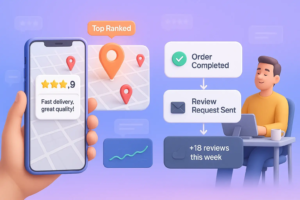
You must automate Google reviews to improve online visibility, gather consistent customer feedback, and establish trust with potential customers.
1. Boosts Visibility in Local Search Results
Google uses online reviews as a ranking factor in local search results.
According to BrightLocal’s survey, 87% of consumers use Google to evaluate local businesses, and the quantity and recency of reviews directly impact visibility.
Businesses that generate frequent Google reviews and respond to them promptly rank higher on Google Maps and local SERPs.
Automated Google review requests help businesses maintain review freshness, increase the number of keyword-rich online reviews, and boost engagement signals that influence local SEO rankings.
2. Saves Time and Ensures Consistency
Manual review requests consume time and lead to inconsistent follow-up.
A Podium study shows that businesses using automated review tools save an average of 3.5 hours per week and increase their review volume by over 40%.
With review automation, you configure triggers once and automatically send Google review requests after specific customer actions are taken.
Automation reduces errors, improves timing, and ensures every customer receives a review request without delay.
3. Increases Revenue
Customers rely heavily on Google reviews when making purchasing decisions.
Research by Spiegel Research Center reveals that products with five or more reviews are 270% more likely to be purchased.
Businesses with more Google reviews enjoy higher conversion rates and increased trust.
Google review automation helps build social proof and reduces decision friction for businesses.
Consistent positive reviews lead to more clicks, more purchases, and more revenue.
4. Builds Trust and Credibility on Autopilot
Trust drives conversions. According to Trustpilot, 89% of consumers read reviews before making a purchase, and 68% trust reviews more when they’re recent and authentic.
Automated review systems generate a steady flow of Google reviews from satisfied customers.
These reviews reinforce your brand’s credibility and demonstrate ongoing customer satisfaction without manual effort.
5. Provides Insights for Improvement
Online reviews provide valuable customer feedback. ReviewTrackers reports that 53.3% of customers expect businesses to respond to negative reviews within a week, and many anticipate further action afterward. Automated review monitoring and tagging tools help you:
Detect service issues early
Identify patterns in customer complaints
Highlight commonly praised features
Review automation not only collects data, but it also drives real-time business improvement and improves customer satisfaction.
Workflow to Automate Google Reviews (WiserReview)
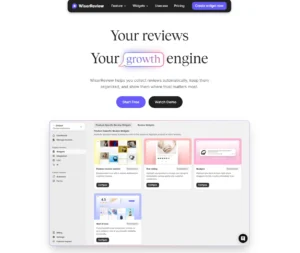
WiserReview is a powerful review automation platform that helps businesses automate Google review requests, improve local SEO, and manage customer feedback.
It integrates with platforms such as Shopify, Stripe, WooCommerce, and CRMs, enabling seamless review request workflows via email, SMS, and WhatsApp.
Show Real Reviews That Build Trust
Collect and display photo, video, and text reviews with full design control.
Step-by-Step Workflow Using WiserReview
You configure WiserReview once, and it runs continuously. The process is fast, intuitive, and deeply customizable.
Here’s how to set it up:
- Start by creating an account in WiserReview and opening the Automate module.
- Select a trigger event, such as a completed purchase, closed support ticket, or finished appointment.
- Connect your ecommerce or CRM platform to allow real-time data syncing.
- Choose the channel to send your review request: email, SMS, or WhatsApp.
- Define when the message should be sent: immediately, after 24 hours, or using business-hour logic.
- Personalize the message using dynamic fields, such as customer name, product, or service.
Then, improve your automation with built-in features:
Segment audiences by order value, product category, or customer region.
Use moderation filters to flag profanity, spam, or low-star ratings automatically.
Showcase reviews on your site using review carousels, floating popups, and trust badges.
Send incentives such as discount codes or thank-you messages after reviews.
Track engagement metrics including open rates, clicks, and submitted reviews.
Launch campaigns via email or SMS to request reviews in bulk.
Connect with tools like Klaviyo, Zapier, Make, WhatsApp, and Google Sheets.
Once all settings are configured, activate the automation. WiserReview starts collecting reviews on autopilot while keeping you in control.
Use WiserReview to build a comprehensive, automated, insightful, and conversion-focused review system.
Automate Google Reviews Using Zapier or Make
You can also automate Google review requests using third-party tools like Zapier or Make.
Zapier Setup

- Trigger: Shopify or Stripe order completed
- Delay: Wait 48 hours
- Filter: Include customers who spent more than $50
- Send email or SMS: Deliver review request with Google review link
- Turn on automation and monitor results
Make (Integromat) Setup
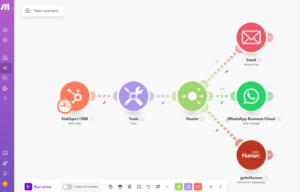
- Trigger: Payment confirmation or CRM event
- Delay module: Add custom delay timing
- Filter by tags: segment customers by region, product, or NPS score
- Send message: email or WhatsApp with Google review link
- Track new reviews automatically
3 Best Practices in Review Automation
Apply these three review automation practices to increase Google reviews, collect higher-quality customer feedback, and create a consistent review management process that scales with your business.
1. Trigger Review Requests at the Right Moment

Businesses must send review requests at the optimal point in the customer journey.
According to a 2023 Birdeye study, the timing of review requests affects conversion rates by up to 40%.
You should trigger review requests after the product has been delivered, the service has been completed, or a ticket has been successfully resolved.
Sending requests too early leads to incomplete experiences. Delays reduce response rates.
Use your automation system to identify these touchpoints and schedule review requests within 24–48 hours.
This approach ensures high engagement and accurate customer feedback.
2. Use Smart Automation, But Keep Human Oversight

Review automation tools manage the logistics, but humans must guide the strategy.
Krunal vaghasiya (Founder of Wiserreview and Wisernotify) advises businesses to monitor automation weekly to flag negative reviews and track message performance. Automated messages should be customized, but monitored for tone, context, and accuracy.
You must review performance metrics, such as open rate, click-through rate, and submission rate.
Use real-time alerts to flag low-star reviews. Assign a team member to respond personally, striking a balance between efficiency and empathy to maintain credibility and trust.
3. Monitor Feedback and Act on Trends
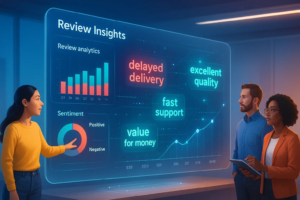
Customer reviews are not just testimonials; they are insights. NLP-based review monitoring tools can extract common keywords, recurring themes, and shifts in sentiment.
For example, if 25% of reviews mention “delayed delivery,” your team must address fulfillment operations. If 70% of reviews praise a product feature, your marketing team must amplify that advantage.
Tag reviews by product, region, or issue type. Review them monthly. Adjust messaging, service, and operations accordingly. Customer feedback must guide decisions, not sit idle in a dashboard.
Potential Challenges & How to Address Them

Review automation increases efficiency but introduces risks. Businesses must handle these carefully.
Failure to do so weakens trust, violates Google’s policies, and harms your brand’s credibility.
Use these quick solutions to prevent common issues.
1. Sounding Robotic or Generic
Customers expect authenticity. A BrightLocal study found that 59% of consumers will not trust a business with templated or generic responses.
If your automated messages sound robotic, your review conversion rate drops. Automation must never replace personalization.
Fix: Personalize every review request using dynamic fields such as the customer’s name, specific product, or service delivered.
Create 3–5 email or SMS templates with different tones or formats. Rotate templates to avoid repetition.
Test subject lines for engagement. Use language that reflects your brand tone. Avoid overused phrases like “We value your feedback.”
Use real, contextual requests, such as “How was your recent haircut at our Denver salon?”
2. Handling Negative Reviews Too Slowly or Poorly
Speed matters. According to ReviewTrackers, 53% of customers expect a business to respond to a negative review within seven days.
Delayed responses can escalate frustration and damage your reputation. Ignoring feedback sends the wrong signal.
Fix: Set up real-time alerts for every new Google review. Assign specific team members to monitor incoming reviews. Respond to negative reviews within 24 hours.
Apologize sincerely. Address the problem. Offer a realistic resolution. Always take the conversation offline if needed, but never leave the public comment unanswered.
Use moderation tools to tag reviews by sentiment, allowing you to prioritize your team’s responses efficiently.
3. Risk of Policy Violations and Fake Reviews
Google has strict policies on review solicitation. Violations can result in review removal or penalties to the business profile. In 2022, Google removed over 200 million policy-violating reviews across its platform.
Fix: Never offer incentives for positive reviews. Avoid gating, which requires customers to leave a review only after they have indicated a positive experience.
Always allow all customers, regardless of satisfaction level, to leave honest feedback.
Ensure your automation system complies with Google’s review policies. Choose tools like WiserReview that include built-in compliance logic.
Monitor automation campaigns monthly to confirm you follow all platform guidelines.
These practices will protect your brand’s credibility while maximizing the benefits of automated Google reviews.
More Than Review Automation: What WiserReview Can Do


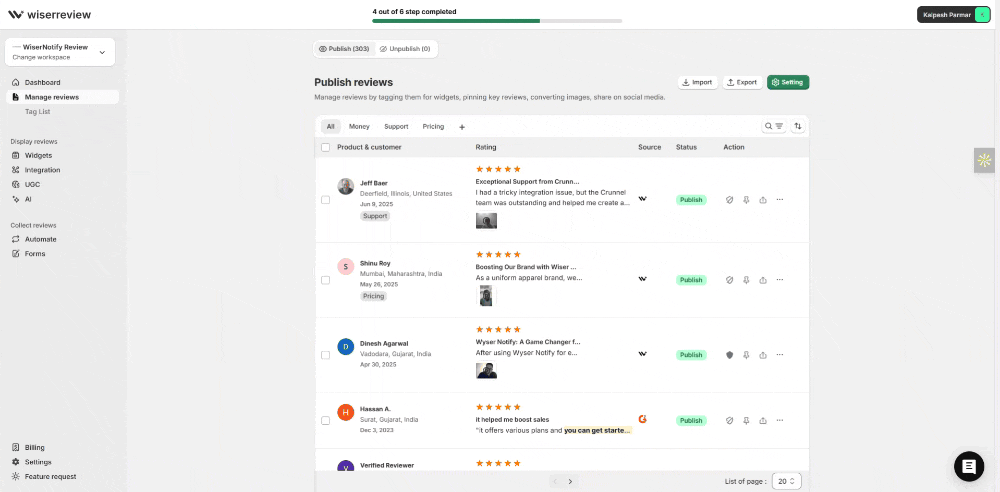
WiserReview is a complete review management platform. You use WiserReview to automate review collection, moderate content, display reviews on your website, and drive new customer trust.
Key Features:
Review Widgets: floating popups, carousels, trust badges.
Review Forms: branded on-site forms to collect Google reviews.
Moderation Filters: flag profanity and tag negative reviews.
Incentives Module: send discount codes after review submission.
Campaign Manager: launch review request campaigns by email or SMS.
Integrations: Shopify, Klaviyo, WhatsApp, Zapier, Make, Google Sheets.
Wrap Up
Automated Google reviews improve customer trust, improve engagement, reduce workload, and improve your online reputation.
You must automate Google reviews to:
Collect consistent reviews
Analyze customer feedback
Improve your Google Business Profile
Convert more customers using social proof
Start with WiserReview or use automation tools like Zapier or Make. Build your review workflow. Monitor results. Optimize performance.
Let your Google reviews grow automatically.




